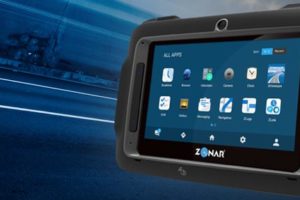Distracted driving remains a significant threat on the roads, and the statistics speak for themselves, with over 3,000 annual fatalities were attributed to distracted driving in the United States, according to the National Highway Traffic Safety Administration (NHTSA) and the U.S. Department of Transportation (DoT).
This article will delve into the root causes of distracted driving, the implementation of best practices, and the pivotal role of fleet management technology in mitigating these risks, all with a keen focus on the needs and challenges faced by fleet managers and trucking compliance experts.
I. Understanding the Peril of Distracted Driving
Distracted driving has insidiously become second nature, particularly when it comes to the allure of our ever-present smartphones. For commercial truck drivers, it is paramount to minimize all distractions while on the road, as even a momentary diversion can lead to catastrophic accidents or injuries. Anything diverting a driver’s gaze from the road or attention from the vehicle presents an unacceptably high risk.
II. Strategies to Combat Distracted Driving
To combat the pervasive issue of distracted driving, fleet managers must emphasize simple but effective strategies that empower drivers to protect themselves against avoidable accidents.
The following best practices are essential:
Pre- and Post-trip Inspections: A driver cannot focus on the road if he hears a strange sound from his vehicle or it begins operating in an unexpected way. Conducting these inspections to make sure the vehicle is operating safely and properly is essential.
Device Management: Drivers should turn off non-essential devices and keep them out of reach before embarking on their journey, ensuring they remain entirely focused on driving.
GPS Pre-Planning: Setting the destination on the GPS before departure and securely mounting the device within the cab is a must, allowing drivers to maintain hands-free navigation.
Defensive Driving: Emphasizing defensive driving tactics helps drivers anticipate the behavior of others on the road, promoting heightened vigilance and accident prevention.
Vigilance: To counteract daydreaming, drivers can engage in a “find the distracted driver” exercise, constantly monitoring their surroundings for indicators of distracted drivers.
Scheduled Breaks: Regular breaks are essential to combat driver fatigue, which poses a considerable risk to road safety.
III. Legal Consequences and Enforcement
While federal laws unequivocally prohibit texting while driving, it is imperative for fleet managers to educate their drivers on the legal repercussions of distracted driving. Employers must enforce a zero-tolerance policy, and company-wide training initiatives should aim to eliminate hazardous behaviors that endanger lives and livelihoods.
IV. Leverage Industry Resources
The Department of Transportation and the National Tank Truck Carriers (NTTC) offer valuable resources for staying up-to-date on best practices in the fight against distracted driving. The NTTC’s “Zero Distractions” campaign is a commendable endeavor to make distracted driving illegal across all U.S. states, and it provides a platform for drivers to pledge their commitment to maintaining unwavering focus on the road.
V. The Integral Role of Technology
As in-cab data and technology continue to permeate the trucking industry, commercial truck drivers face unique challenges in managing distractions. It is crucial for these technologies to enhance safety, rather than exacerbate the problem.
The following considerations are pivotal:
Selective Device Usage: Opt for devices that enable greater oversight and the ability to communicate with drivers, while restricting access to non-essential applications, ensuring that devices designed for navigation and driver coaching take precedence.
Advanced Safety Systems: Invest in vehicle safety technology, including reverse sensors, cameras, adaptive cruise control, and hands-free Bluetooth connectivity. These innovations enable drivers to remain focused on the road, reducing the risk of accidents.
Real-time Monitoring: Implement systems like Zonar Coach, which continually monitor driver behavior, providing real-time feedback on speed, swerving, and aggressive braking — all telltale signs of distracted driving. Such systems also capture video evidence, enabling drivers to learn from past mistakes and managers to commend safe driving practices.
VI. In-Cab Cameras: A Crucial Tool for Coaching and Exoneration
One of the most pivotal advancements in fleet management technology that warrants a comprehensive discussion is the implementation of in-cab cameras. These devices serve a dual purpose of both coaching and exoneration, thereby augmenting the overall safety and compliance strategy for fleet managers and trucking compliance experts.
Coaching for Continuous Improvement: In-cab cameras offer an invaluable resource for coaching drivers towards continuous improvement. These cameras provide real-time insights into driver behavior, allowing managers to assess driving habits, identify areas for enhancement, and offer targeted coaching.
By using recorded footage, coaching sessions can be tailored to address specific issues such as aggressive braking, speeding, or lane deviations. This personalized approach empowers drivers to take responsibility for their actions and adapt to safer driving practices, contributing to a culture of constant improvement within the fleet.
Exoneration and Liability Mitigation: In addition to driving coaching, in-cab cameras serve as a vital tool for exoneration and liability mitigation. Accidents on the road can lead to complex legal disputes and liability claims.
In-cab cameras, by providing clear and objective evidence of what transpired during an incident, can help exonerate drivers when they are not at fault. This capability is invaluable in protecting drivers from unjust accusations and reducing legal expenses for the fleet. It also underscores the commitment of the fleet to transparency and accountability in the event of an accident.
Enhancing Overall Safety: In-cab cameras play a pivotal role in enhancing overall safety by serving as a silent observer of driver behavior. This constant vigilance ensures that drivers remain mindful of their actions, knowing that their performance is being monitored.
The knowledge that video evidence is available encourages drivers to adhere to safe driving practices, thus reducing the occurrence of accidents caused by distracted driving. Furthermore, it can serve as a deterrent against risky behaviors, such as texting while driving, contributing to a safer road environment for all. In-cab cameras are a game-changing technology that significantly contributes to the enhancement of fleet safety and compliance. They facilitate driving coaching, empower drivers to improve, and provide essential evidence for exoneration and liability mitigation. As indispensable tools for safety management, in-cab cameras play a crucial role in fostering a culture of responsibility, safety, and accountability within the fleet management industry.







